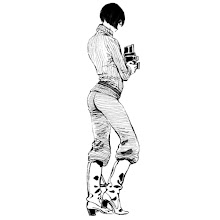E' un pò un incognita questo cambio Vittoria in una delle sue ultime versioni dotato di "forchette" deragliatrici poste sotto al carro e dunque senza la necessita di retropedalare per effettuare la cambiata.
Il primo mistero riguarda l'anno di lancio sul mercato, questo esemplare è stato rinvenuto su di una bici da corsa marcata 1938 e analizzando l'unico documento dell'epoca della ditta Nieddu riguardante questo cambio viene riportato 37-38, lo si può vedere nell'ultima foto che ritrae la pagina della brochure Vittoria.
(foto tratte dal sito Ruote di Carta). La logica e i fatti impongono di pensare che si tratti dell'ultima versione del cambio Vittoria, databile quindi proprio sul finire degli anni 30, anche se alcune voci fanno risalire questo cambio addirittura ai primi anni 50... molto strano dato che nel dopoguerra la Vittoria lanciava sul mercato il nuovo cambio Cervino.
Il secondo mistero riguarda il nome... sempre analizzando il testo del catalogo Vittoria viene specificatamente chiamato Vittoria Margherita Tour de France, ma sempre nella borchure viene fatto cenno all'appellativo "Il Campionissimo", lo si può vedere sia nella prima pagina in alto, sia nel titolo dello schema tecnico.
Sempre nello schema tecnico, nella legenda, viene riproposto il nome Campionissimo unicamente per quanto riguarda il deragliatore, è come se il cambio in sè fosse il classico Vittoria Margherita modello TdF, con il nuovo deragliatore Campionissimo... un pò contorta la scelta di utilizzare una sequela infinita di nomi, ma forse potrebbe essere la soluzione!
Ovviamente mi rivolgo a tutti gli appassionati del cambio Vittoria, torinesi e non, se hanno informazioni a riguardo o notizie più precise potranno sicuramente aiutarci per risolvere questi piccoli grandi dubbi!

























2 commenti:
Many thanks for the interesting article. Here in Argentina there seem to be three models, the first is changed by actually touching the chain, the second one we see here is very similar to the one in your pictures. The third is a little more sophisticated and allows the rider to keep pedaling forwards while changing. Unfortunately there seem to be a lot of copies of some of the minor parts, mostly the rear changer and the oiler on the frame. These copy parts sometimes help to complete a restoration, but are sometimes sold to people who think everything is genuine. The copy parts can be found being sold in the USA, but I am not sure where they are actually made. I have heard that when Vittoria stopped production, there were a lot some parts left over in targe quantities, for example the main swinging arm. It is obviously not good in my opinion to see and old and new mix of parts.
Your article is very interesting indeed. I have never seen the type of rear changer you show in your pictures, which was very interesting.
Kind Regards.
Sorry not to have been able to respond in Italian.
David
Many thanks for the interesting article. Here in Argentina there seem to be three models, the first is changed by actually touching the chain, the second one we see here is very similar to the one in your pictures. The third is a little more sophisticated and allows the rider to keep pedaling forwards while changing. Unfortunately there seem to be a lot of copies of some of the minor parts, mostly the rear changer and the oiler on the frame. These copy parts sometimes help to complete a restoration, but are sometimes sold to people who think everything is genuine. The copy parts can be found being sold in the USA, but I am not sure where they are actually made. I have heard that when Vittoria stopped production, there were a lot some parts left over in targe quantities, for example the main swinging arm. It is obviously not good in my opinion to see and old and new mix of parts.
Your article is very interesting indeed. I have never seen the type of rear changer you show in your pictures, which was very interesting.
Kind Regards.
Sorry not to have been able to respond in Italian.
David
Posta un commento